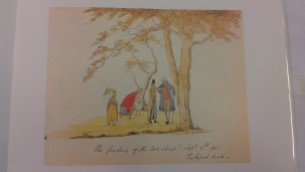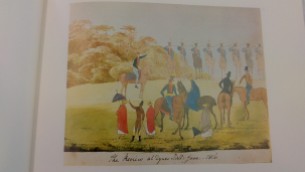Learn about the red dress that Emma’s character wears in the film
No spoilers, this is all about the costumes!
I have to say more about this wonderful film… Emma wears the dress that Thalia wears in The Thread of Destiny!!! Oh my gosh. That is my favourite dress which is why I clothed a character in this dress in my book. 😀

I feel complemented, for absolutely no valid reason, that the makers of this film used the same dress that I have previously used in a book. Ha Ha. (I am laughing at myself). And now you can see what the red dress would have looked like in real life. Just imagine Thalia with her short, tightly sculpted auburn hairstyle in the fashion of Caroline Lamb’s in THAT red dress. No wonder my hero was smitten, hey? 😉
You can tell how tickled I am by this fact, because I am gushing.
Earlier in the film I had noticed another brief fashion of that period, the coral jewellery that the characters wore which is something I had spotted in the Victoria & Albert Museum in London too, and then came the dress, which is also on display in the V&A Museum. 😀 That, of course, is where I discovered it.
I have never used coral jewellery, but I have used another brief fashion of that era, for pewter jewellery. In the latest of The Wickedly Romantic Poets’ books, Treacle Moon, Polly wears her aunt’s pewter jewellery. if you ever visit the V&A, the pewter jewellery is displayed in the same area of the museum as the coral jewellery.
Many of the women in Emma also wear the sheer white muslin with small embroidered patterns of the kind that I dressed Ellen in, in my first regency novel. Ellen wore a dress like that the night she went to her first ball with Edward, and if you read my blogs at that time, you will know that that dress was also a real one that I had seen in The Fashion Museum in the Assembly Rooms in Bath 😀
I imagine for the film they must have worked with fashion historians. It always amazes me, though, just how carefully made and how intricate the work of fashion was in these times. Just look at the detail on the back, over the shoulders and across the front in all the designs of the long ‘pelisses’ and the short ‘spencer’ coats that the women wear in the film. When you then remember that all of those items were made by hand… It is all very awe inspiring when you see the items recreated so beautifully in a film.
And the bonnets! Just a couple of days before I watched the film I read my favourite scene from The Illicit Love of a Courtesan, to practice for a public reading, (when Ellen meets Edward by agreement for the first time in the park). In that scene I describe her bonnet and the outfit I had seen on a contemporary fashion plate, again, to see that level of detail in a film was beautiful. I loved all of it, including the bonnet acting; displaying how to hide behind and peer around the brim of a bonnet, and how a man might lean in to kiss a woman beneath the brim. Bonnet teasing is something I use a lot in books. 😀
Oh, but one last gush, then I will stop. I also enjoyed watching Knightley walk through his hall of statues 😀 and the landings lined with broken statues; a reality that I have captured in John’s home, my scandalous duke.
Oh no that was not the last, another funny little quirk of the film, that shows the lack of underwear in the women’s costume when Emma simply lifts up her skirt and warms her bottom. Tee hee.
There is only one thing that was not quite right. They had a very beautiful horse-chestnut tree framing Emma in a scene that was addressed as the summer. Horse-chesnut trees flower in the spring; I also use them in scenes in my books. 😉
Gush over.
I give the film a glimmering 5 Stars, I will probably go back to watch it again and it is definitely one to buy on DVD so I can keep it.
discover Jane Lark’s books

























